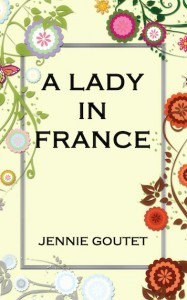Jennie Goutet's Blog: A Lady in France, page 36
June 6, 2014
Six Châteaux on the Loire: Chambord
Chambord is pronounced shahm-bore, and it’s probably the most prestigious château in the Loire Valley. It’s certainly the largest, boasting 440 rooms, 365 windows, 282 fireplaces, 83 staircases, as well as the many turrets and dormer windows.

Chambord was seldom inhabited, and that’s probably because it’s simply not very habitable. There is a pretence at protection, but it is certainly not a château-fort (a fortress). François I began its construction to be used as a hunting lodge, but only stayed there a few weeks.
 François II continued the construction, but it was not completed until Louis XIV. That’s why it’s sort of half-gothic, half-rennaissance.
François II continued the construction, but it was not completed until Louis XIV. That’s why it’s sort of half-gothic, half-rennaissance.
 You will never guess who the initial architect was. At least I would never have guessed. (It’s in dispute. Everyone agrees he had influence over the plans, but others state him as the official architect). Okay, okay, I’ll put you out of your suspense.
You will never guess who the initial architect was. At least I would never have guessed. (It’s in dispute. Everyone agrees he had influence over the plans, but others state him as the official architect). Okay, okay, I’ll put you out of your suspense.
 It’s Leonardo da Vinci! Did you even know he was an architect among the other things? I did not. But he was buddies with François I.
It’s Leonardo da Vinci! Did you even know he was an architect among the other things? I did not. But he was buddies with François I.
It’s a dubious honour, however – although perhaps not his fault, considering he only began the construction but did not complete it. Chambord is considered by architects to be somewhat of a travesty. The balance of the rooms is not pleasing, and the windows are not symmetrical.


And there are so many turrets and spires, author Henry James said of it “the towers, cupolas, the gables, the lanterns, the chimneys, look more like the spires of a city than the salient points of a single building.”
 So I thought the best way to tackle this behemoth of a building is to show you pictures. But please don’t expect any order to them. I will show you edifices and windows and floors and details and landscapes in such a hodgepodge that you will be as thoroughly turned about as I was when visiting it. So without further ado, here are:
So I thought the best way to tackle this behemoth of a building is to show you pictures. But please don’t expect any order to them. I will show you edifices and windows and floors and details and landscapes in such a hodgepodge that you will be as thoroughly turned about as I was when visiting it. So without further ado, here are:
The windows


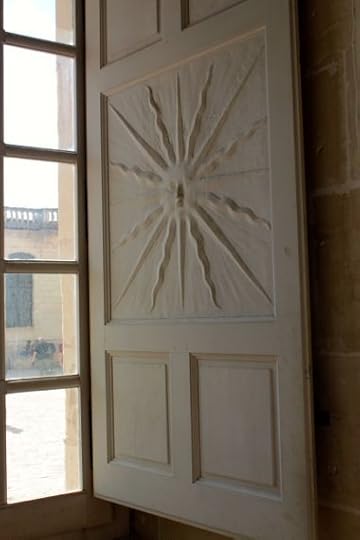
The floors


The corridors


The rooms
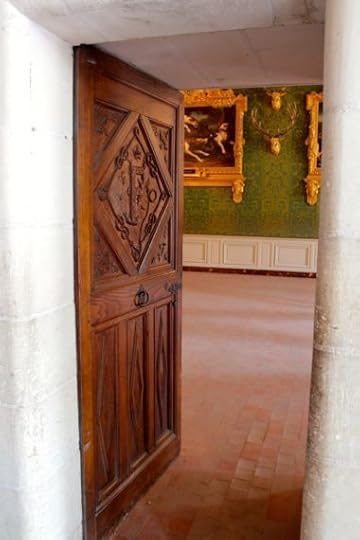
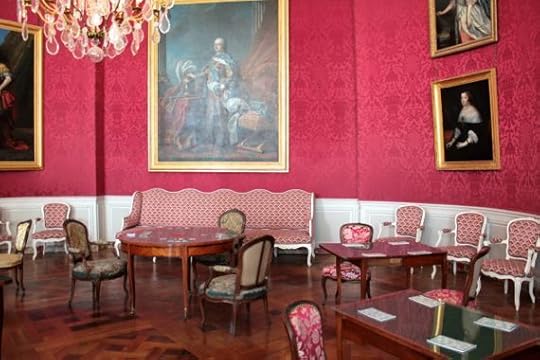


The view


The moulding

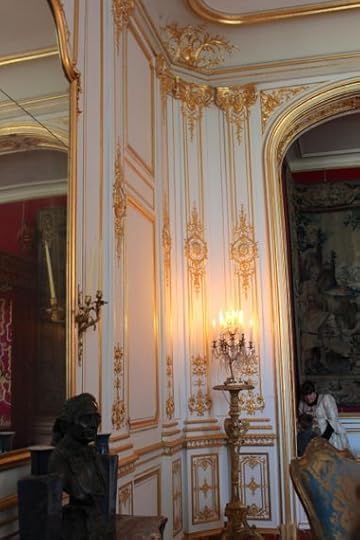

The furnishings


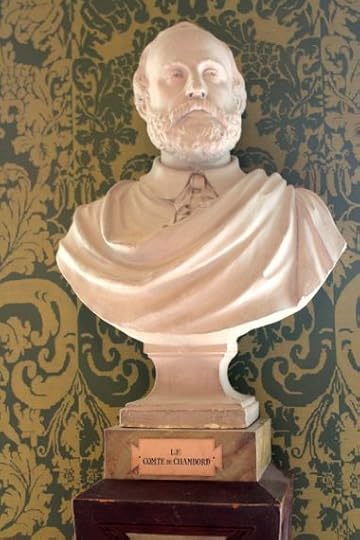
The doors



The spires, turrets and steeples



I have to say, though, that whether he was the architect of Chambord, all the historians agree that da Vinci designed these incredible spiral staircases, in which you can go up and down the different sides at the same time without ever meeting.


Clever, huh?
You had forgotten that there was one last château to look at, didn’t you? But this brings us to six. (Or seven, if you count Tours).
And I hope you enjoyed the whole tour. Groan.
 (I got my information here, here and here).
(I got my information here, here and here).
The post Six Châteaux on the Loire: Chambord appeared first on A Lady In France.
June 3, 2014
Summer Rice Salad
I tried rice salad for the first time when I came to France. I don’t think I realised such a thing existed, nor would I have considered it fit for a complete meal. But now . . . add a little cheese platter and a piece of fruit, and it’s a perfect meal for a summer day.
It’s also perfect as a shared dish for a barbecue.
I cooked two cups of rice, which gives about double that amount when it’s cooked. If you need a refresher course on how to make rice, I have a tutorial here.
Then I took a large bowl and started with a heaping tablespoon of dijon mustard. Don’t I always start with a heaping tablespoon of dijon mustard? It’s my second favourite ingredient, next to crème fraiche.
To that I added a tablespoon of balsamic vinegar and four tablespoons of olive oil. I kind of let it spill over, rather than measure it exactly.
 When that was done, I added a family size tin of tuna. It was 400 grams with the water. I broke the tuna into pieces and mixed it with the sauce.
When that was done, I added a family size tin of tuna. It was 400 grams with the water. I broke the tuna into pieces and mixed it with the sauce.
 Then I added a can of corn, 3 diced tomatoes and a cup of olives chopped into pieces.
Then I added a can of corn, 3 diced tomatoes and a cup of olives chopped into pieces.
 While I was waiting for the rice to finish cooking, I sautéed two small shallots in another tablespoon of olive oil. That takes a bit of the pungency away, while still adding excellent flavour to the dish.
While I was waiting for the rice to finish cooking, I sautéed two small shallots in another tablespoon of olive oil. That takes a bit of the pungency away, while still adding excellent flavour to the dish.
 When the rice was done, I added it while still hot. I find that it brings out the flavour and softens the tomatoes without cooking them.
When the rice was done, I added it while still hot. I find that it brings out the flavour and softens the tomatoes without cooking them.
Mix it all together.
 And then I added the shallots and another tablespoon of balsamic vinegar, plus a half teaspoon of salt. And I mixed it all thoroughly.
And then I added the shallots and another tablespoon of balsamic vinegar, plus a half teaspoon of salt. And I mixed it all thoroughly.
 And that’s it! Easy peazy nice and breezy. Time for a barbecue!
And that’s it! Easy peazy nice and breezy. Time for a barbecue! 
Speaking of which, do you know where the word barbecue comes from? It’s French for barbe au queue, which means from the beard to the tail. In other words, when you’re roasting a pig, the spike goes from one end to the other.
Sorry for the graphic description.
Ahem.
Um. Now back to the rice.
Summer Rice Salad Print Prep time 10 mins Cook time 20 mins Total time 30 mins From: Jennie Goutet Recipe type: Salad Cuisine: French Serves: 6 Ingredients 2 cups rice before it's cooked 1 heaping tablespoon of dijon mustard 2 heaping tablespoons of balsamic vinegar 5 heaping tablespoons olive oil (one used to cook the shallots) ½ teaspoon salt 1 cup olives chopped 3 tomatoes dices 1 can corn 1 large can of tuna 2 small shallots Instructions Cook the rice Mix the vinaigrette, saving 1T olive oil for shallots Mash the tuna Add the tomatoes, olives and corn Add the cooked rice, the shallots and salt Stir and serve. It tastes best still warm or room temperature. Do not put in the refrigerator. 3.2.1310
The post Summer Rice Salad appeared first on A Lady In France.
June 1, 2014
My First Vlog Ever!
Alright, it’s not really a vlog – (for non-blogging friends, this means video log) – it’s an interview.
Rod Jetton, author of Christian non-fiction book, Success Can Kill You, did a review of my book here. And he liked it well enough to ask me for an interview, which was a huge encouragement for me.
I never thought I would do a vlog because it’s so hard to get out of the comfort and anonymity of my computer screen, but this was not something I could pass up. So . . . without further ado . . . if you would like to see my face, and hear my voice talking about faith, depression, writing, and a bit about life, let me present:
I hope you liked the interview and don’t forget to follow Rod on twitter and Google+ and his blog.
The post My First Vlog Ever! appeared first on A Lady In France.
May 27, 2014
Spiritual Fasting
A couple of years ago, my husband and I started doing forty-day fasts, and we’ve been doing them about twice a year ever since. It’s not that we don’t eat at all for forty days; but on any given fast, we’ve done a combination of the following:
Two-to-three days per week of liquid only -or liquid plus smoothie / vegetable soup purée.
Limit food to a small bowl at each meal.
Fasting things we like – coffee and sugar for me; bread and cheese for the Frenchman.
Fasting all TV and books, except for spiritual books.
Get up at five or six AM to read and pray.
Isaiah 58 is a great reference for what true fasting is, as is Zechariah 7. It’s not a ritual to be followed to fulfil the law. It’s all about the heart. “Administer true justice; show mercy and compassion to one another. Do not oppress the widow or the fatherless, the foreigner or the poor. Do not plot evil against each other.”
There are Biblical reasons for fasting, apart from any fast set out by church schedule or religious authorities (although those are perfectly fine if the heart is in the right place). Let’s take a look at some of those.

A Biblical Fast
Fast for guidance:
The early church was continually breaking new ground (undergoing persecution, salvation for the gentiles, a risen Messiah). They had to remain constantly in prayer to know what to do. In Acts 13, here is one example. “While they were worshipping the Lord and fasting, the Holy Spirit said, ‘Set apart for me Barnabas and Saul for the work to which I have called them.’ So after they had fasted and prayed, they placed their hands on them and sent them off.” They didn’t run the church the best they could as they saw fit – they constantly relied on God through fasting and prayer. (See also Acts 14:23)
Fast for others:
When the saints (that means you and me, as well as the heroes of old) were urgent for their loved ones – or on a larger scale – for their people, they prayed and fasted. It’s impossible to fast effectively without prayer. The first form of fasting is self-reliant (and uncomfortable). The other is an urgent and glorious communication with an Almighty God.
When Daniel found out that Jerusalem would lay in ruins for seventy years, he was so distraught, this was his reaction: “So I turned to the Lord God and pleaded with him in prayer and petition, in fasting, and in sackcloth and ashes.“
It was common in those days to tear your garments and cover your head with dirt and ashes to show how miserable you were. Of course, later on, people kept the ritual of tearing clothes and/or putting ash, but there was no feeling behind it. No agony, no distress . . . no feeling at all. Daniel, on the other hand, gives a beautiful example for a prayer of confession and supplication on behalf of the Israelites in Daniel 9.
Fast when there’s a major life change:
Did you know that there were two “Saul”s in the Bible? There was the first Israeli king before David was chosen. And there was Saul (later called Paul) who persecuted the Christians to death for years before this happened:
“As he neared Damascus on his journey, suddenly a light from heaven flashed around him. He fell to the ground and heard a voice say to him, ‘Saul, Saul, why do you persecute me?’
‘Who are you, Lord?’ Saul asked.
‘I am Jesus, whom you are persecuting,’ he replied. ‘Now get up and go into the city, and you will be told what you must do.’
The men travelling with Saul stood there speechless; they heard the sound but did not see anyone. Saul got up from the ground, but when he opened his eyes he could see nothing.” Acts 9
Saul was so troubled about what God was doing. He was so overwhelmed, torn apart, speechless with shock and (I imagine) grief for his part in the murders, “For three days he was blind, and did not eat or drink anything.“
Fast when there is great distress:
One of the most beautiful stories of our shared heritage with the Jews is the story of Esther. She was a young Jewess who was chosen to be queen. Her uncle learned of the enemy’s decree to kill every Jew in the land , and he went to her as the only person who could do something about it. And this was this brave young woman’s response:
“Go, gather together all the Jews who are in Susa, and fast for me. Do not eat or drink for three days, night or day. I and my attendants will fast as you do. When this is done, I will go to the king, even though it is against the law. And if I perish, I perish.’ Esther 4
Fast for deliverance
Very close to the feeling of great distress was the urgent prayer for deliverance. Jonah was ordered to preach to the Ninevites their impending destruction if they would not repent. And here’s what happened in Jonah 3.
“Jonah began by going a day’s journey into the city, proclaiming, ‘Forty more days and Nineveh will be overthrown.’ The Ninevites believed God. A fast was proclaimed, and all of them, from the greatest to the least, put on sackcloth.
When Jonah’s warning reached the king of Nineveh, he rose from his throne, took off his royal robes, covered himself with sackcloth and sat down in the dust.” God saved them from destruction because they humbled themselves – from the greatest to the least.
Fast for protection:
Ezra was part of the remnant that was returning to Jerusalem from Babylon, which was far from being danger and trouble-free.
“There, by the Ahava Canal, I proclaimed a fast, so that we might humble ourselves before our God and ask him for a safe journey for us and our children, with all our possessions. I was ashamed to ask the king for soldiers and horsemen to protect us from enemies on the road, because we had told the king, ‘The gracious hand of our God is on everyone who looks to him, but his great anger is against all who forsake him.’ Ezra 8
Ezra relied on prayer and fasting for protection rather than the king’ soldiers and horsemen. And once those words were out there, he couldn’t get nervous, start to doubt, and change his mind. He fasted for protection.
Fast for God to act:
Nehemiah was an exile like Ezra. He was the cupbearer to the king, and when he found out about the state of the wall in Jerusalem, he wanted to go do something about it. But a captive servant doesn’t just say to the king, “Sorry. I’ve got to go see about a thing.”
He needs the king to be in a good mood, look upon his request favourably and – not only NOT put him in prison for his audacity – but actually let him go!
“When I heard these things, I sat down and wept. For some days I mourned and fasted and prayed before the God of heaven.” You can read the rest of his prayer in Nehemiah 1.
The King not only let him go, but he also gave him a letter to ensure his safe crossing.
Now that we’ve looked at some different reasons for fasting, let’s take a look at how to fast. I’m not talking about what to give up. I’m talking about what the state of your heart when you fast.
With perfume and makeup!
I mean, not if you’re a guy and all. But don’t let people know you’re fasting by looking all somber and gaunt. Here’s what Jesus said. ‘When you fast, do not look sombre as the hypocrites do, for they disfigure their faces to show others they are fasting. Truly I tell you, they have received their reward in full. But when you fast, put oil on your head and wash your face, so that it will not be obvious to others that you are fasting, but only to your Father, who is unseen; and your Father, who sees what is done in secret, will reward you. Matthew 6
So don’t, for instance, shout out on the worldwide web that you’re fasting so that everyone will think you’re spiritual because that will be your reward.
Oh . . . wait . . .
With a softened heart:
Honestly, this could have been listed with the reasons to fast, but I chose to put it here. This is the biggest reason that we fast. We live a relatively safe and trouble-free life. It’s so easy to get lulled into complacency. We want to rend our hearts. We want to get close to God in ways we are unable to do when we’re going about our daily business, not even feeling a tinge of discomfort.
“Rend your heart
and not your garments.
Return to the Lord your God,
for he is gracious and compassionate,
slow to anger and abounding in love,
and he relents from sending calamity. Joel 2
The point being? Fast with a soft heart or there’s no point in doing it at all. And then you will see the face of your beautiful God, who is gracious and compassionate, slow to anger and abounding in love.
With a surrendered heart:
David was the beloved king of Israel, and a man after God’s own heart. But he still sinned. He committed adultery, got Bathsheba pregnant, and had her husband killed so he wouldn’t find out. Nathan was not afraid to tell him like it was, and David accepted the rebuke.
He understood that he had sinned against God so a mere man could say whatever he wanted to him. It didn’t matter that he was king. Nathan warned him the child would die, and David fasted for the child to live. But when the child finally did die, he got up and ate. This surprised his servants.
He answered, ‘While the child was still alive, I fasted and wept. I thought, “Who knows? The Lord may be gracious to me and let the child live.” But now that he is dead, why should I go on fasting? Can I bring him back again? I will go to him, but he will not return to me.’ 2 Samuel 12
Fast and pray to get what you want. But be surrendered if you don’t get what you’re asking for.
And . . . finally - we can’t do better than to look at the way Jesus fasted, and that is:
With scriptures:
“Then Jesus was led by the Spirit into the wilderness to be tempted by the devil. After fasting for forty days and forty nights, he was hungry. The tempter came to him and said, ‘If you are the Son of God, tell these stones to become bread.’” Matthew 4
After not eating or drinking in the desert for forty days and nights, Jesus was hungry. That is the understatement of the millennium. Satan tempted Jesus first in his physical weakness. Then he dug for pride, saying if you are really loved by God, then no harm will befall you. When neither of those caused Jesus to stumble, he threw a last minute snare out for greed. Jesus fought back with Scriptures every time.
Fasting can make you grouchy. And when your boss is breathing down your neck, or your kids are running circles around the couch, whooping like cowboys, you might not be in the best frame of mind to respond graciously. But fasting is no excuse to toss aside truth, nobility, righteousness, purity, loveliness, and grace.
Fasting is a chance to see God.
Droit d’auteur: huandi / 123RF Banque d’images
The post Spiritual Fasting appeared first on A Lady In France.
May 25, 2014
The Birds and the Beasts
I found the strangest (largest) green beetles eating up my roses. I find them to be as pretty as the roses, but am not happy about their eating habits.

Here’s another rose (there are five bushes clumped together with four different varieties).

And here’s our rose bush over the well (which I show you every spring). It blooms in May. Very pretty, but no scent.
 And my peony is blooming for the first time in my garden. Upon closer look, it seems that there’s another one of those large green beetles, tucked in the petals. I’ve never seen these guys before. They must not hatch every year.
And my peony is blooming for the first time in my garden. Upon closer look, it seems that there’s another one of those large green beetles, tucked in the petals. I’ve never seen these guys before. They must not hatch every year.
 The peach tree we planted in memory of Alistair – the baby we lost – is doing much better this year. There are eight peaches total!
The peach tree we planted in memory of Alistair – the baby we lost – is doing much better this year. There are eight peaches total!
 And the capucine (I forgot the English name) seems to be springing up on its own now. What a cheerful bug repellant!
And the capucine (I forgot the English name) seems to be springing up on its own now. What a cheerful bug repellant!
 We’ve transplanted the strawberries from under the apple tree to their own little wooden boxes.
We’ve transplanted the strawberries from under the apple tree to their own little wooden boxes.
 And in the middle, we planted a cherry tree. It will be cute! I hope it doesn’t get so big that it shades the strawberries, but I guess we’ll cross that bridge when we come to it.
And in the middle, we planted a cherry tree. It will be cute! I hope it doesn’t get so big that it shades the strawberries, but I guess we’ll cross that bridge when we come to it.
 The raspberries are just beginning to show up.
The raspberries are just beginning to show up.
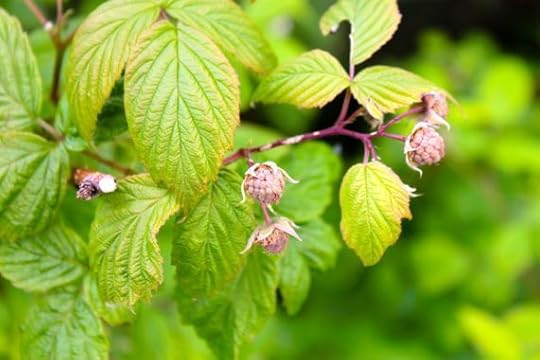 And the lavender over there in the corner that used to be a weed-fest is starting to do nicely, even though it’s not a super sunny spot. We covered it with wood bark to keep the weeds at bay and to prevent moss and other ground cover from forming. I like the lavender here. It’s white – so different from our other two blue and purple varieties.
And the lavender over there in the corner that used to be a weed-fest is starting to do nicely, even though it’s not a super sunny spot. We covered it with wood bark to keep the weeds at bay and to prevent moss and other ground cover from forming. I like the lavender here. It’s white – so different from our other two blue and purple varieties.
 And this is a before shot. We plan to fill the wooden box with earth and plant garish red and yellow annuals that I wouldn’t want to put anywhere else in the garden. (I’m a pink, white and purple flower lover). And then next to the wooden box in the small plot of grass, I will plant calla lilies.
And this is a before shot. We plan to fill the wooden box with earth and plant garish red and yellow annuals that I wouldn’t want to put anywhere else in the garden. (I’m a pink, white and purple flower lover). And then next to the wooden box in the small plot of grass, I will plant calla lilies.
 Next to that wooden box is another that’s already filled. Did you know that sage flowered so prettily?
Next to that wooden box is another that’s already filled. Did you know that sage flowered so prettily?
 This is the part of the house that we see when we first walk through the front gate, and I love it! I love the brick wall, the flowering plum tree, the wood bark. We’re working on the plants, but this area is filling out nicely.
This is the part of the house that we see when we first walk through the front gate, and I love it! I love the brick wall, the flowering plum tree, the wood bark. We’re working on the plants, but this area is filling out nicely.
 And here’s another area that’s coming along, but needs more work. We need to paint the wall and studio white, and put some outdoor wood tiles for the floor, but this is a sweet little outdoor patio with a potted olive tree in the corner (that I hope will get bigger).
And here’s another area that’s coming along, but needs more work. We need to paint the wall and studio white, and put some outdoor wood tiles for the floor, but this is a sweet little outdoor patio with a potted olive tree in the corner (that I hope will get bigger).
 Hunter caught another bird.
Hunter caught another bird.
 Can you see his brother or sister in the branch there? I heard Juliet shriek and – surprisingly – Hunter dropped his prey.
Can you see his brother or sister in the branch there? I heard Juliet shriek and – surprisingly – Hunter dropped his prey.
 But it was too late for the poor birdie. He didn’t stand a chance. His tail wasn’t even fully developed and he was no expert at flying.
But it was too late for the poor birdie. He didn’t stand a chance. His tail wasn’t even fully developed and he was no expert at flying.
Juliet was traumatised.
 But she felt a little better after determining that the two remaining birds were old enough to forage and this was not the mother he had killed.
But she felt a little better after determining that the two remaining birds were old enough to forage and this was not the mother he had killed.
 Gabriel dealt with his feelings in his own way.
Gabriel dealt with his feelings in his own way.
 And William talked.
And William talked.
 This picture is really for the grandparents who will be astonished at how much he has grown.
This picture is really for the grandparents who will be astonished at how much he has grown.
 Today was Mother’s Day in France, and Gabriel bought me earrings with his own money. He was so proud. He looked at me wearing them at church, and he said, “I keep thinking that you have new earrings, and I forget that I was the one who bought you those earrings!”
Today was Mother’s Day in France, and Gabriel bought me earrings with his own money. He was so proud. He looked at me wearing them at church, and he said, “I keep thinking that you have new earrings, and I forget that I was the one who bought you those earrings!”
He asked me if I was going to tell everyone that he was the one who had bought them for me, and I said, “Absolutely!”
We went out to eat and it reminded me that I had been meaning to write some tips about dining out in France. I put them on my Facebook Fan page (did you like my page yet?) but I thought I would put them here if you want to pin them for later. You never know when you’re going to get whisked off to France for dinner!
(PS I know there’s a tiny typo in it, but I would have to start from scratch to fix it. Ugh.)

Happy Memorial Day my beloved American friends and family!
The post The Birds and the Beasts appeared first on A Lady In France.
May 20, 2014
Happy People Everywhere!
You guys, my new children’s book just came out.

You can download the book by clicking on the image.
It’s actually not all that new. In fact, it’s 22 years old. I wrote and illustrated it when I was living in Asia and teaching children. My husband put it on PowerPoint right after we were married a decade ago. He also improved a lot of the images, like turning – what looked like – smiley faces in jail (Happy Zoo) into adorable smiley animals.
But it wasn’t until this whole self-publishing thing became an option that I could make the book available. I had completely forgotten about it after my memoir, and my husband encouraged me to dig it out. My designer put it into publishable format and chose a really cute font, and . . . voila!
The book is free on Kindle for 5 days, and I wanted to ask if you could help me spread the word, and also download it, even if you don’t have age-appropriate children. This will make it more visible on Amazon.
Thanks. And . . . that’s it.
Then we’re really back to our regularly scheduled programming. I promise. 
The post Happy People Everywhere! appeared first on A Lady In France.
May 19, 2014
Beginner’s Guide to Self-Publishing and Marketing
I am taking a break from our regularly-scheduled programming to share with you a step-by-step guide for how to publish and market a book. It’s an Idiot’s Guide, if you will, because I’m basically telling you exactly what you need to do.
Of course you can do something else, but I was really looking for someone to tell me exactly what to do when I was self-publishing so I wouldn’t have to spend hours on research. Well, I hope those hours of research will benefit you too.
I should mention that I did not receive compensation in any form for this post.
Why Self-Publish?
As you probably know, self-publishing has become a reputable thing. Sure, it feels good to have someone else say your work is good enough to represent, or (the golden egg) to actually publish. But here are some reasons why self-publishing is preferable to traditional publishing:
- You don’t have to put your fate and your dreams into anyone else’s hands. You can make it happen, and on your timetable.
- Most people can’t tell that your book was self-published when they’re trawling the Amazon site.
- You earn up to 70% royalties (on Kindle), as opposed to about 10% with traditional.
- You decide when it gets published, and don’t depend on an editor’s schedule.
- You decide what will go on the cover, and you can make edits to the cover or interior as soon as you find them. When you go with a traditional publisher, you’re at their mercy for making changes, big and small. And sometimes they say no.
- Even if you’re with a traditional publisher, you still have to do your own marketing. Sure, you’ll get some help, but a lot of it falls on you. If that’s the case, why not reap a greater monetary benefit from your efforts and do it yourself?
Now, I should tell you, by way of disclaimer, that I’m no bestseller or anything. To date, I’ve only sold about 200 books. But that’s why this is called an idiot’s a beginner’s guide, and not a master’s guide. Considering that most books never sell more than 200 copies in their whole shelf life, and most authors never sell enough even to earn their advance, the way I see it – anything above and beyond 200 is frosting!
For those who are still with me, let’s begin.
 Preparation& Publishing
Preparation& PublishingStep One: As an author, you will ideally already have a blog, a personal Facebook account, as well as a Facebook fan page. You will be on twitter, Google+ and (it’s always helpful) – Pinterest.
If you don’t have these things, sign up. Follow people you admire on twitter (celebs), and follow people who will hopefully be your peers as well – those who will likely follow you back. Your little profile blurbs can mention your book, but they should be about you. Your tweets and FB updates should also be about you.
Install Tweetdeck (it’s not hard) to organise your tweets for you. Start a Facebook fan page – it’s easy! But just make one for you, the author. Otherwise, if you make one for each book, there are too many places you have to keep updated.
Make it a goal to write a short blog post on your blog once a week. Post pictures, tell about your life, do book reviews, cook! Whatever interests you. The most important thing is building relationships. Your tweets and FB shares cannot be 100% about your book or people will block you.
Sound like a lot of work? It is. But people rarely buy books from someone they’ve never heard of. At the bare minimum, have a blog/website, a twitter handle and a FB fan page.
Step Two: Make sure you’ve had your book professionally edited. If possible, have a few beta readers read and edit the book before your professional edit, and even afterwards. A beta reader is any friend or acquaintance who has a good grasp of the English language, and who will not be afraid to give you solid advice and critique. For a professional editor, I highly recommend mine, Lizzie Harwood.
And don’t forget that even after you receive your professional edits, you will need to proofread again and again. There are always those tiny mistakes that make it through. I was vigilant, and a friend still caught three after my book was published.
Step Three: Hire a cover & internal layout designer. I was not crazy about the the covers I saw that were designed by the CreateSpace team (which you have to pay for). Also, they offer to convert your file for you to upload on kindle, but then you don’t own the file and you can’t send it to other people for free (in order to get reviews, for example).
My cover designer was Lacey O’Connor (lranda@hotmail.com), and I recommend her. She did the front and back cover, my internal layout for print, for kindle, and for other e-book formats, as they are not all the same. She also did a single cover for me to upload on Facebook, and she gave me all the files so I could keep sending them out.
A word on formatting for e-readers:
The files you will need are pdf for the print version, as well as for the iPad and some e-readers.
As for the e-readers, there is Kindle (from Amazon) which needs a mobi file.
There is also the Nook (Barnes & Nobles), Kobo (from Borders) and Reader Throw Down (from Sony) - and all three need an EPub file, though they also accept other files, such as pdf.
Step Four: Upload to CreateSpace. This part is free. I recommend you use their ISBN number because that is also free, and I’ve found that there was no reason I needed to have my own. I read a lot about it first before making that decision. For the Kindle version, you’ll get an ASIN number, which serves the same purpose, and which is also provided for free. The Kindle version is not done through CreateSpace. We’ll get to that.
Step Five: You need to include metadata. These are the key word searches that you input for the description. You can choose one category for your print book, and you can choose two for kindle. In addition, you get five to seven key words. I recommend using their words – their categories and sub-categories as your key words. It doesn’t matter if the category has two words (like “feelings & emotions) – the words are only counted by the comma between each one.
Step Six: You have to go to KDP Amazon to upload your kindle file. I recommend choosing 70% royalties instead of 35% because I can’t think of why you wouldn’t want to earn more money on your title. I think you should allow for the open distribution (don’t try to limit people sharing your book). Don’t be stingy about free books, book lending, giveaways because it’s a cheap form of publicity and there will always be readers who pay for it.
One last piece of advice on Kindle. I would go for the Kindle Select program for at least three months. It means you can’t upload your book to be made available to any of the other e-readers, which can be limiting. However, you can let people download the book for free for a certain number of days. And that will shove you right up in the page ranks of Amazon and make your book more visible. I think the positive aspects of doing this outweigh the negative. And when you’re ready to quit KDP Select and just have an ordinary kindle account so that you can upload for other e-Readers, the simplest thing to do will be to publish on Smashwords. They will make your book available for e-readers everywhere.
A word to the wise. Make sure your cover and title accurately represent your book. The only two negative reviews I had were to do with the fact that the cover and title were misleading. They expected (I imagine) a fictional romance. And instead they got a memoir about grief and faith. If I had to do it over, I probably would have changed both.
Marketing
Step One: If you’re not content with the beginner’s guide, and want the master’s guide, read this before you publish!
Step Two: If you are already a blogger, ask friends and acquaintances (in advance) to do a book review of your book right after it comes out. You should already have been supporting their blog or they will likely not be willing to do the extra work. Make a schedule so that all the reviews don’t fall on the same day. Provide the book for free, and as a nice gesture, link back to them on your own blog on the day their review comes out, saying what you appreciate about their work.
A word on reciprocity. Do your best to read, review and share others’ work. At times people will support you when you cannot return the favour. At other times you’ll support someone who cannot do the same for you. But your reputation precedes you, and it should be one of generosity of spirit.
Step Three: If you’re going to do the 5 days free on Kindle Prime Select (recommended), check out these sites FIRST and decide which ones you will add your book to for extra publicity. Let me reiterate - you can’t give away too many free books. There will always be other people who will want to buy it (because they prefer print or want to give it as a gift or heard about it somewhere), and free books = publicity.
You should plan your free days to fall on Tuesdays through Thursdays, and contact those promo sites in advance. Many of them require 2 weeks notice, although not all. However, I don’t recommend telling your friends and family your book is out until the five free days are OVER! The people who are going to pay for your book are the ones who know you. The ones who will discover you are more likely to do so if your book is free. You can also split the five free days and not use them all at once.
Step Four: Do a giveaway on Goodreads. (Join Goodreads if you haven’t!!). I recommend giving five copies and making the giveaway a month long, and although you have to pay for the print copies to be sent out, it’s not that much with your CS discount. Many of the people who sign up to win the giveaway will add your book to their “to-read” list so you’ll get tons of publicity like that. All of their goodreads friends will see that they’ve added your book.
Step Five: If you decide to do a paid marketing campaign on Goodreads, do it at the same time as your giveaway. Start with a small sum, like $25, and use a high cost-per-click ratio, like 50 cents per click. I found that I didn’t get a lot from this, and that’s why I’m recommending a small sum. You won’t need to ask for your money back like I did. Study samples of other ads before you create your wording.
Step Six: You need reviews. You can sign up here to do an author review swap on Goodreads. You read 4 books in exchange for 4 people reading yours (but they are not the same people). You must leave a review on goodreads and amazon for each book you review, so that’s 4 more reviews for you in both places.
Step Seven: Another great place to get reviews in exchange for giving away free electronic versions (and 3 small Amazon gift certificates) is The Story Cartel.
Step Eight: Submit your book to national book awards. Why not, right? The five cream of the crop awards are found on this website. And the rest of them – many of which seem worthwhile to me (although it can start to get costly), are found here. This is a great thing to put on your bio, and it could get you lots of sales and recognition, even if you were “only” shortlisted. Pay attention to the time of year. All awards are different, but figure out quickly which ones you want to do and note the deadline for each. Most are at the beginning of the year, and since most of them are only for books released the prior year, time is of the essence.
Step Nine: Join Freado. This has an application called BookBuzzr, which is free, and which allows you to put a widget to preview your book on your blog or FB page. Mine is over there to the right - the one that says “A Lady in France Book.” I know it’s not the right size for my sidebar – it’s cut off – and I have a similar widget from Amazon that I could probably do away with. I’ll get to that later.
You’ll figure it out. Although you can get the widget for free, I paid for Freado’s premium service, and I’m almost certain some of the sales can be tracked to that website. I know I can do more to invest in that website, and I will when some of the more pressing deadlines are over.
Step Ten: Actual advertising. I’m only just getting around to this five months in. My budget is not unlimited, but I’m going to advertise on Christian websites for just one month. That’s all I can afford, and I finally surrendered to the fact that it’s my target audience. I wanted my book to reach everyone, no matter where they stood regarding faith, but I can see that the people who will appreciate it most are the ones who share the same faith. So off I go, narrowing my focus for my target audience.
Narrow your focus when you advertise.
Tracking Sales
You only need to know one thing about this, and that is this: There is not one website that shows you all the books you’ve sold.
The print copies that you sell are found in your Member Dashboard on CreateSpace, and your Kindle copies that you sell are found on your KDP Amazon page.
In addition . . . for Kindle, you have to click on “Reports” to see the Sales Dashboard or the Month-to-Date Unit Sales. But even then, in the monthly sales, you will only see the Amazon.com sales. If you want to see how much you sold from other countries, you either need to click on each individual country (there’s a drop down menu), OR you need to click on the Sales Dashboard. This will show you a graph of how much you sold, and it will include all the countries.
A reminder that becoming a premium member of Freado will allow you to receive a daily e-mail telling you your Amazon rank each day – the high and the low, and this is not a bad thing.
It Doesn’t Hurt to . . .
Step One: Add this application to your FB page. It’s self explanatory, and you can click on my FB page to see what it looks like. It’s the red button up top that says, “Read my Book.”
Step Two: Read this post by my new friend Candace Walsh (author of Licking the Spoon). It’s got ten additional marketing tips (I love the one about getting people to take pictures with your book and pinning it or sharing on FB). And there is also a link to her website where she shares her book club document. Because yes! Contact local book clubs and see if they would be interested in reading your book. She’s created a list of questions that you can use as a basis for your own document. And, ahem, I have yet to finish mine.
Step Three: Contact Pubslush to raise money for your book. This can be pre-publication, in order to pay for design and editing. It can also be post-publication to pay for marketing, advertising, and even translating into other languages.
Step Four: Do monthly Amazon Kindle giveaways for as long as you decide to remain in their Select program. Do another goodreads giveaway. Give books away on your FB fan page. My friend Kristin Duncombe, author of Trailing and fellow expat in France, said that every time she gives her book away, her sales shoot up. And her book is doing very well.
Step Five: You can do an Orangeberry Book Tour, which is not that expensive and they are very good at communicating – very nice people. But I feel like I should add a caveat. A lot of the blogs that feature the participating books don’t seem to have much of a soul. They generally only post whatever the Orangeberry authors contribute (whether book excerpts or guest posts) so I can’t vouch for how many readers actually read the blogs (or buy the participating books). However, with the more complete package, you’re guaranteed 20-25 honest reviews on Amazon, so that is a good thing.
Step Six: Brand yourself. The image where your book cover should go (on Amazon, FB, Goodreads, etc) should always have the image of the cover of the book. And wherever you need to put an author photo (twitter, blog, Amazon, etc), there should be one. No space for an image should remain blank. Try to use the same head shot everywhere so people recognise you.
I think I’ve covered most of the basics. Marketing can be a serious time-suck, and it’s really exhausting when you’re trying to figure it all out (on top of writing, and (likely) being a parent, and carrying on a full-time job . . . . My advice is to set a time limit each day and do what you can and be at peace with that.
Also, the best thing you can do for your book sales is to keep writing more books. The more people like your style, the more fans you will have who will then buy the books that you have already published, increasing both visibility and sales.
And that’s it. What about you, authors? Do you have any great tips to share? Please leave them in the comments so we can all benefit. 
The post Beginner’s Guide to Self-Publishing and Marketing appeared first on A Lady In France.
May 14, 2014
Six Châteaux on the Loire: Ussé
ARE YOU GETTING SICK OF THE CHÂTEAUX YET? I must admit that I feel weary. But I’m nothing if not stubborn, so there’s just Ussé and then Chambord and then maybe I’ll change things up and cook something.
Ussé is pronounced ew-say, with an accent on the say, and what’s impressive about this château is that the Duc of Blacas still lives there. It’s been in the family for awhile. What’s also impressive about it is – unlike the castle of Neuschwanstein in Bavaria, which inspired the design of the Sleeping Beauty castle at Disneyland -the Château d’Ussé is the real deal. Charles Perrault (1628-1703), who wrote the fairy tale, Sleeping Beauty, was a guest in this castle and he based the story on this place.
Cool, huh?
 He also wrote Puss in Boots, Little Red Riding Hood and Cinderella.
He also wrote Puss in Boots, Little Red Riding Hood and Cinderella.
Et oui! Those stories did not just appear out of thin air.
Alright, so Ussé. There are four areas of interest. There’s the chapel, the stables, the winery and the château itself. Let’s go one by one.
The Chapel
These two Lebanese cedars just outside the chapel were a gift to the duchess from Chateaubriand in 1808.

(You can see they have supports so that the low branches won’t take root).
 The chapel was built in 1528 by Charles d’Espinay and his wife Lucrèce de Pons.
The chapel was built in 1528 by Charles d’Espinay and his wife Lucrèce de Pons.
 Another chapel was built in the village a couple of centuries later, so this became a private family chapel. The first wedding celebrated there was for servants (isn’t that so sweet?) in 1672. The last wedding that took place there was in 1918 (Count Louis de Blacas and his wife, who are both buried in the family vault underneath the chapel). The current Duke’s two children (Stanislas and Hortense) where christened here in the 80s. His grand-daughter, Aliénore, was christened here in 2011.
Another chapel was built in the village a couple of centuries later, so this became a private family chapel. The first wedding celebrated there was for servants (isn’t that so sweet?) in 1672. The last wedding that took place there was in 1918 (Count Louis de Blacas and his wife, who are both buried in the family vault underneath the chapel). The current Duke’s two children (Stanislas and Hortense) where christened here in the 80s. His grand-daughter, Aliénore, was christened here in 2011.
 Five centuries of people have trod on these floors.
Five centuries of people have trod on these floors.
Here is the altar.
 And the view looking out.
And the view looking out.
 The Stables
The Stables This is the view from the chapel towards the stables on the right. There are many tunnels in the cliffs, dating to Roman times when people lived in the mountainside. You can see the door to these caves in front of you.
This is the view from the chapel towards the stables on the right. There are many tunnels in the cliffs, dating to Roman times when people lived in the mountainside. You can see the door to these caves in front of you.
In the stable it smells of leather.
 And here you see the old ceiling, as well as various types of carriages, all used at different times and for different purposes (noble, peasant, work, entertainment, etc).
And here you see the old ceiling, as well as various types of carriages, all used at different times and for different purposes (noble, peasant, work, entertainment, etc).
 Here’s another view with the stable at our back. You can see the old carriages and the ancient homes in the wall/mountain. It’s possible I am wrong here, and this was used as a quarry rather than homes. However, in this area, there is an abundance of troglodytes (which I mentioned in another post) and I think I remember reading that that’s what these were in Ussé.
Here’s another view with the stable at our back. You can see the old carriages and the ancient homes in the wall/mountain. It’s possible I am wrong here, and this was used as a quarry rather than homes. However, in this area, there is an abundance of troglodytes (which I mentioned in another post) and I think I remember reading that that’s what these were in Ussé.

The Winery
 The winery is where the old quarry was. They harvest pierre de tuffeau, which means freestone. Freestone encompasses limestone and sandstone, and indicates stones that can be cut in any direction. This was perfect for building.
The winery is where the old quarry was. They harvest pierre de tuffeau, which means freestone. Freestone encompasses limestone and sandstone, and indicates stones that can be cut in any direction. This was perfect for building.
However, once the castle was built and they no longer needed the quarry, they turned it into a place to make wine.
 The Château
The Château This is what we’re really interested in, isn’t it?
This is what we’re really interested in, isn’t it?
The castle is shaped like a horse-shoe, and the left-hand tower is below.
 Let’s take a look at some of the intimate details inside the castle. The stone is not super strong, and you can see how worn it is on the steps.
Let’s take a look at some of the intimate details inside the castle. The stone is not super strong, and you can see how worn it is on the steps.
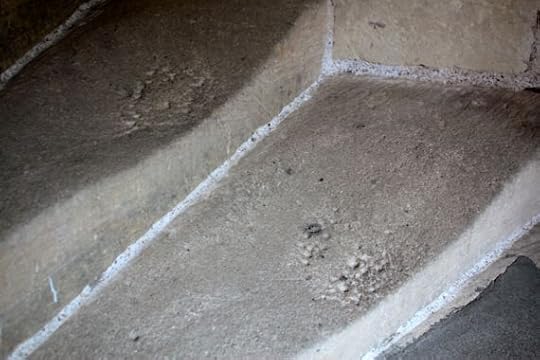 The money to visit the castle goes towards renovations, and honestly it is in very good shape. They’ve outfitted most of the stairs with wood to protect them from further erosion.
The money to visit the castle goes towards renovations, and honestly it is in very good shape. They’ve outfitted most of the stairs with wood to protect them from further erosion.
 Inside the castle there are some little charming details. The wooden floors:
Inside the castle there are some little charming details. The wooden floors:
 The sharp, angular roof, as seen from a window.
The sharp, angular roof, as seen from a window.
 There are touches of home everywhere that remind one this castle is still inhabited.
There are touches of home everywhere that remind one this castle is still inhabited.
 Here is the duke’s crest:
Here is the duke’s crest:
 And . . . this is the part that’s off-limits to the rabble. This is where the duke’s family actually lives (an annex connected to right of the horseshoe).
And . . . this is the part that’s off-limits to the rabble. This is where the duke’s family actually lives (an annex connected to right of the horseshoe).
 Here’s the view from high up. A French garden.
Here’s the view from high up. A French garden.
 Ussé has treasures in every corner. Here are some of the toys from centuries past.
Ussé has treasures in every corner. Here are some of the toys from centuries past.
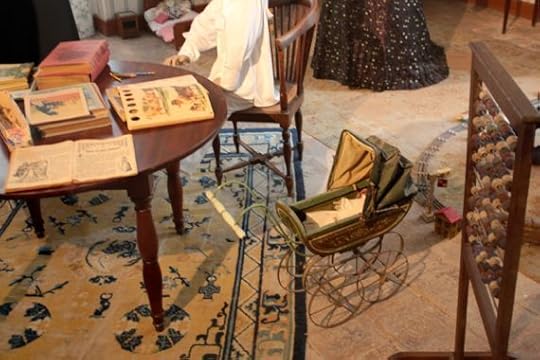 Miniature chair and table set for doll.
Miniature chair and table set for doll.

Guests to the castle can wander through the attic and peek at forgotten treasures that now gather dust.
 I don’t know about you, but I like old stuff!!
I don’t know about you, but I like old stuff!!
 Eventually, we need to get to what makes the château glamorous – the beautiful interior. Here’s the staircase.
Eventually, we need to get to what makes the château glamorous – the beautiful interior. Here’s the staircase.
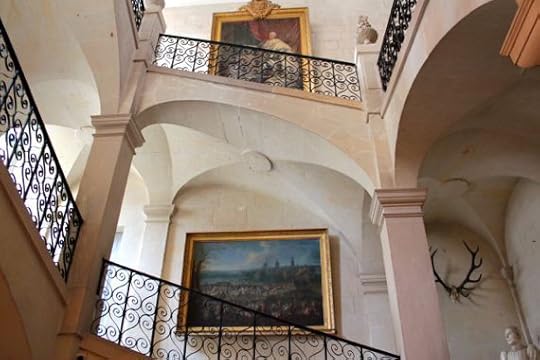 And in the entranceway is a knee-high canon that they still shoot off every time a family member is born.
And in the entranceway is a knee-high canon that they still shoot off every time a family member is born.
 Here we have some of the early mirrors.
Here we have some of the early mirrors.
 Can you see the servant’s door discreetly cut out of the wall?
Can you see the servant’s door discreetly cut out of the wall?
 Ussé has mock scenes showing costumes and customs from times gone by.
Ussé has mock scenes showing costumes and customs from times gone by.
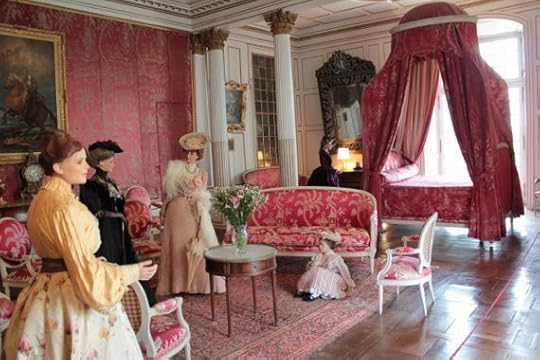


Sometimes they bring everything to life.
 and
and

sometimes they give the castle an ethereal feel.
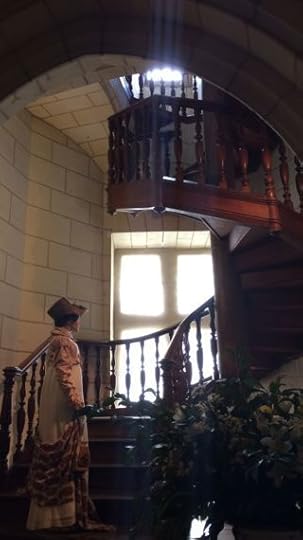 They also have a whole reenactment of Sleeping Beauty, but it was too dark to get good pictures. Your kids will love that though.
They also have a whole reenactment of Sleeping Beauty, but it was too dark to get good pictures. Your kids will love that though.
Below, the ceilings were painted to look like marble. This was the style a couple of centuries back.
 All the colour gives warmth to the room.
All the colour gives warmth to the room.
 There are also the long, sunny marble corridors. (Here it smelled like someone was making soup, which made the castle cozy).
There are also the long, sunny marble corridors. (Here it smelled like someone was making soup, which made the castle cozy).
 And now we’re entering into the servant’s quarters of old – the kitchen and the furnace.
And now we’re entering into the servant’s quarters of old – the kitchen and the furnace.
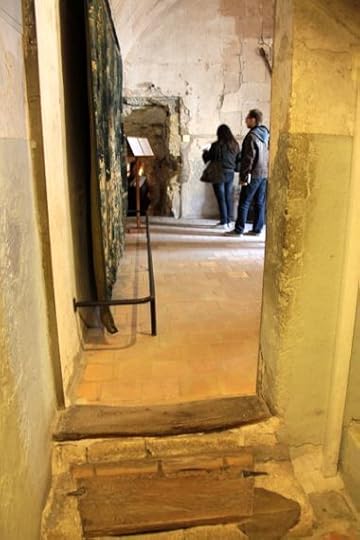 You take these steps to go down to the furnace.
You take these steps to go down to the furnace.
 And here it is. Very run down, but at one time it was top of the line to have central heating, and this ole thing heated the entire château, consuming many tons of coal a day, with four full-time workers shovelling it in. Today the new furnace consumes gallons of fuel each day, but I can’t remember the exact numbers.
And here it is. Very run down, but at one time it was top of the line to have central heating, and this ole thing heated the entire château, consuming many tons of coal a day, with four full-time workers shovelling it in. Today the new furnace consumes gallons of fuel each day, but I can’t remember the exact numbers.
 Shall we stop here? On this rusty old furnace? Why, no! I say that’s sacrilege! Let’s talk about the history.
Shall we stop here? On this rusty old furnace? Why, no! I say that’s sacrilege! Let’s talk about the history.
The château was first built by a Viking in 1000. It changed hands until it was bought by Jacques d’Espinay in 1485 (whose wife was a lady-in-waiting to the Duchess of Brittany (was that Anne?). Their son built the chapel. The château changed hands over the centuries, and after the Revolution, it went to the Dowager Duchess of Duras, who was a famous author, exploring sexual and racial equality. She held famous literary salons in the castle (to which she invited Chateaubriand). It went to her daughter, and then her daughter’s nephew, who was the Count de Blacas, the last man to be married in the chapel.
 And that was Ussé.
And that was Ussé.
 Next up – last up – is Chambord.
Next up – last up – is Chambord.
The post Six Châteaux on the Loire: Ussé appeared first on A Lady In France.
May 8, 2014
Six Châteaux on the Loire: Azay-le-Rideau
I leave the châteaux for two weeks and I’m completely lost! They all run together into one grand building of tall rafters, woven tapestries, tiny glass window panes, stone spiral staircases, and extensive grounds.
But after a bit of refreshing my mind with the pictures and studying websites, such as this, this and this, I can confidently say that this
 is Azay-le-Rideau. Pronounced Ah-Zay-le-Ree-Doe.
is Azay-le-Rideau. Pronounced Ah-Zay-le-Ree-Doe.
Azay-le-Rideau was built at the beginning of the XII century as a medieval fortress by the Lord Ridel d’Azay. (Rideau comes from Ridel). He built it to protect the road from Tours to Chinon at the pivotal point where it crossed the river Indre. During the 100 Year War, (which was as much between the Burgundian and Armagnac factions of France as it was between France and England), Charles VII was fleeing the Burgundy seat in Paris to go to the Armagnac stronghold in Bourges when he was mocked by the Burgundian soldiers staked out in Azay-le-Rideau. As a result, he burned the château and put the 350 soldiers to the sword, and the town was called Azay-le-Brulé (Azay the Burned) until the 18th century.
 In 1518, Gilles Berthlot, who was the Mayor of Tours and the Treasurer of the King, bought the château remains to restore and reflect his distinguished position. He kept the medieval foundation, but added on in the 16th century Italian Renaissance style so that it combines the beauty of both.
In 1518, Gilles Berthlot, who was the Mayor of Tours and the Treasurer of the King, bought the château remains to restore and reflect his distinguished position. He kept the medieval foundation, but added on in the 16th century Italian Renaissance style so that it combines the beauty of both.
 In order to lay the foundation, he had to have stilts put into the soil made wet by the river. And then he wanted to bring the strong, solid stones to build it from the quarry in St-Aignan. But that was 62 miles away and they had to be brought in by boat. In all, the construction was very slow.
In order to lay the foundation, he had to have stilts put into the soil made wet by the river. And then he wanted to bring the strong, solid stones to build it from the quarry in St-Aignan. But that was 62 miles away and they had to be brought in by boat. In all, the construction was very slow.
 Over ten years later, the château was still incomplete when Berthelot’s cousin (the chief minister in charge of royal finances) was executed and it forced him to go into exile, perhaps fearing his own exposure for misappropriation of funds. And when Francis I gave it to one of his knights in arms, Antoine Raffin, in 1537, he only made minor changes and the château retains its “distinctive, but accidental” L-shape to this day.
Over ten years later, the château was still incomplete when Berthelot’s cousin (the chief minister in charge of royal finances) was executed and it forced him to go into exile, perhaps fearing his own exposure for misappropriation of funds. And when Francis I gave it to one of his knights in arms, Antoine Raffin, in 1537, he only made minor changes and the château retains its “distinctive, but accidental” L-shape to this day.
 Raffin’s granddaughter began modernising the decor, and her son’s wife was the future governess to Louis XIV. As a result, the château received its first royal visit in 1619 by Louis XIII, and then again later in the century, by his son, King Louis XIV.
Raffin’s granddaughter began modernising the decor, and her son’s wife was the future governess to Louis XIV. As a result, the château received its first royal visit in 1619 by Louis XIII, and then again later in the century, by his son, King Louis XIV.
 The Raffins owned the château until 1791 when it was sold to Charles de Biencourt. It stayed in the de Biencourt family until they were forced to sell in the late 19th century due to financial difficulties. It was then bought by the State in 1905 to be classified as an historical monument.
The Raffins owned the château until 1791 when it was sold to Charles de Biencourt. It stayed in the de Biencourt family until they were forced to sell in the late 19th century due to financial difficulties. It was then bought by the State in 1905 to be classified as an historical monument.
You enter into the château grounds through the gift shop in the outlying hamlet.
 And once inside, you go up the central stone staircase
And once inside, you go up the central stone staircase
 with the carved railings.
with the carved railings.
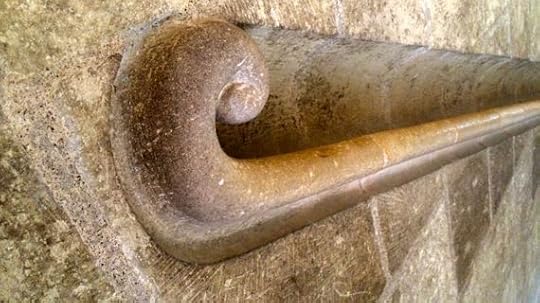 Here are some of the interesting features of the château. The window panes,
Here are some of the interesting features of the château. The window panes,
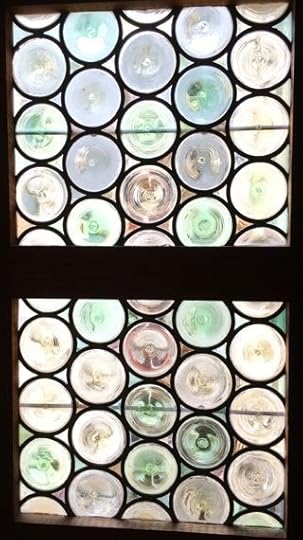 the wooden shutters that are sectioned off into squares,
the wooden shutters that are sectioned off into squares,
 and the view on the river.
and the view on the river.
 The stairwells,
The stairwells,
 the classic example of French roof-building at the time
the classic example of French roof-building at the time

 tapestries (of course).
tapestries (of course).
 Laaaarge chimneys (that’s me standing there)
Laaaarge chimneys (that’s me standing there)
 and trick paintings. See it?
and trick paintings. See it?
 And see it here?
And see it here?
 And here?
And here?
 It’s really a mirror that fits the three paintings behind it perfectly, depending on where you are standing.
It’s really a mirror that fits the three paintings behind it perfectly, depending on where you are standing.
And there are the bedrooms
 the royal insignias that were uncovered after the French Revolution.
the royal insignias that were uncovered after the French Revolution.
 And . . . the hidden kitchen.
And . . . the hidden kitchen.
 The last family covered up the old kitchen, which was a sunken room, and turned it into a dining room. When the State later did renovations, they partially uncovered it again to show the kitchen as it originally was.
The last family covered up the old kitchen, which was a sunken room, and turned it into a dining room. When the State later did renovations, they partially uncovered it again to show the kitchen as it originally was.
This is the billiard room where the men drank brandy (I imagine).
 This is the informal dining room
This is the informal dining room
 and the parlour (I think) – what was once the former dining room.
and the parlour (I think) – what was once the former dining room.
 The back of the château has a gate that leads straight to the town!
The back of the château has a gate that leads straight to the town!
 But wanna know what Azay-le-Rideau is really known for? This.
But wanna know what Azay-le-Rideau is really known for? This.
 A perfectly reflected mirror of the château on the river.
A perfectly reflected mirror of the château on the river.
 Small wonder Balzac called it ‘a facetted diamond, set in the Indre.’
Small wonder Balzac called it ‘a facetted diamond, set in the Indre.’
Next up: The Château of Ussé
The post Six Châteaux on the Loire: Azay-le-Rideau appeared first on A Lady In France.
May 4, 2014
Personal News, Writing News
I thought I’d take a break from our tour of the châteaux just to tell you how things are going over here, and to include a few pictures for the grandparents.
After our five days in the Loire, just the two of us, we had a weekend away as a family. This was needed as well. It’s hard to connect with the children when we’re busy working or doing other things. We went to a water park in Picardie, about 2 hours from Paris.
It was a charming little resort village that resembles Disney, only cheaper,
 and with all sorts of extra-curricular things to do.
and with all sorts of extra-curricular things to do.
 The plus was how nice the accommodations were.
The plus was how nice the accommodations were.
 For a family vacation, they were exceptional.
For a family vacation, they were exceptional.
 The negative was choosing a water park early enough in the season that only the indoor part was open. When we arrived, the screen lit up with the dreaded words “619 Visiteurs!” I made number 620.
The negative was choosing a water park early enough in the season that only the indoor part was open. When we arrived, the screen lit up with the dreaded words “619 Visiteurs!” I made number 620.
Now you can see this place is not big. (Photo taken the next day with only 60 people inside).
 And the screams and splashes echo loudly indoors. Outside was a wonderful expanse with other pools and other watersides, so I imagine the whole is a dream come true during the summer season.
And the screams and splashes echo loudly indoors. Outside was a wonderful expanse with other pools and other watersides, so I imagine the whole is a dream come true during the summer season.
 But cramped inside like that was more of a nightmare.
But cramped inside like that was more of a nightmare.
Still, the kids loved the wave pool
 and all the other water accessories.
and all the other water accessories.
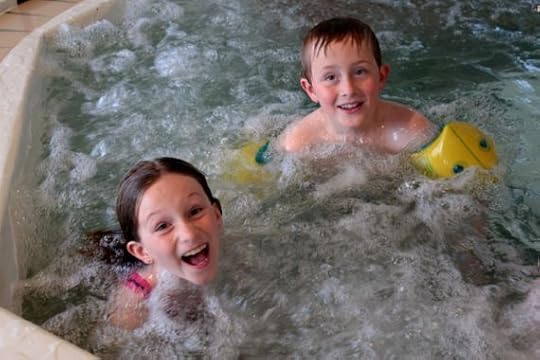 And – as any parent knows – if they are having fun, we are having fun.
And – as any parent knows – if they are having fun, we are having fun.
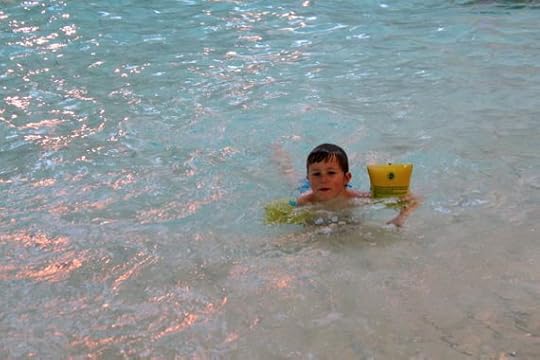 In other news, somebody also turned ten.
In other news, somebody also turned ten.
 We did a 50′s style (give or take 15 years) rock party.
We did a 50′s style (give or take 15 years) rock party.
 We decked out my office as a dance studio,
We decked out my office as a dance studio,
 complete with my husband, the deejay.
complete with my husband, the deejay.
 There were electric slide dance lessons
There were electric slide dance lessons
 as well as the “Battle of the Bands.”
as well as the “Battle of the Bands.”
 Everyone said they had an amazing time.
Everyone said they had an amazing time.
 And my daughter is still young enough that the younger brothers are invited.
And my daughter is still young enough that the younger brothers are invited.

 Good thing too, because then the token boy “Viktor” was not alone.
Good thing too, because then the token boy “Viktor” was not alone.
 I think this is the 4th year he’s been loyal to his “amoreuse” – my daughter, Juliet. When he came back from his recent trip to Poland, he gave her presents and chocolate, and she said, “C’est quand-même bien d’avoir un amoreux. Tu auras des cadeaux!“
I think this is the 4th year he’s been loyal to his “amoreuse” – my daughter, Juliet. When he came back from his recent trip to Poland, he gave her presents and chocolate, and she said, “C’est quand-même bien d’avoir un amoreux. Tu auras des cadeaux!“
(It’s good to have a crush after all. You get presents!) She says he’s just a friend though.
Our Internet may never be fixed until a couple of years pass and they rip up the streets and fix the old wires that are buried underground. I’ve made peace with it, though. Lately it seems to be working most of the time and it really forces me to do other things than being glued to my computer.
We’ve made the decision to keep our dog, Hunter. The guy we really thought would take him decided he didn’t want him after spending those 5 days with him, and I felt sad to think of letting him go. What if he wasn’t happy there? We also got advice to make sure he sees us eating in front of him first so he knows we’re the masters. And we’re making an effort to let him spend lots more time with us upstairs. All in all, it seems to be working so far. He seems to have calmed down a LOT.
Sales on my book are slow, but steady. And it always helps to have reviews. I’m part of a Goodreads review exchange program, and it’s interesting to get people who don’t know you, and are not necessarily interested in your genre.
Yesterday, I got a good review on my book from that group. It was good in that it had some very helpful (and just) criticism, but she still gave me four stars for the writing. Even as I was publishing the book, I could see where it needed work, but it was very important for me to go ahead with it so I didn’t lose courage completely. I’m glad I did, even though I would have written it differently now.
My husband reminded me that I had written a children’s book twenty years ago – light on text and filled with cheerful graphics. I drew it by hand and he put it on powerpoint, and made some cute changes. Well, I’ve talked to my cover designer, and she’s going to fix the font and put the whole thing in publishable format. So I will have a children’s book out soon!
Otherwise, I am trying my hand at fiction. I’m trying to write without worrying too much about how good it is, and then I’ll go back and fix everything the same way I did with my memoir. If I can just get the story down, I know I can improve it later. It’s the plot that’s hard – the plot, and persisting until it’s done.
I have to tell you, though. Until it’s done, I won’t be sure if I can actually write anything other than a memoir – if I’m skilled enough to pull it off.
So I feel myself drifting pleasantly lately (most of the time). I have no intentions of giving up my blog, but the reduced Internet does affect it. I also know that if I am to continue writing longer works, I cannot keep up a four-day-a-week blog schedule. I feel peaceful about that, like I’m moving towards something else – towards more extended writing. Fiction for now, and hopefully faith-based non-fiction at some point when I feel like I have something to say.
But as for blogging . . . I don’t think I would be happy spending months writing one book without the immediacy of sharing the little things – the family, the recipes, cool French stuff, my heart . . . And the friendships and contacts I get through blogging are irreplaceable.
So for now, A Lady in France is here to stay. 
The post Personal News, Writing News appeared first on A Lady In France.

